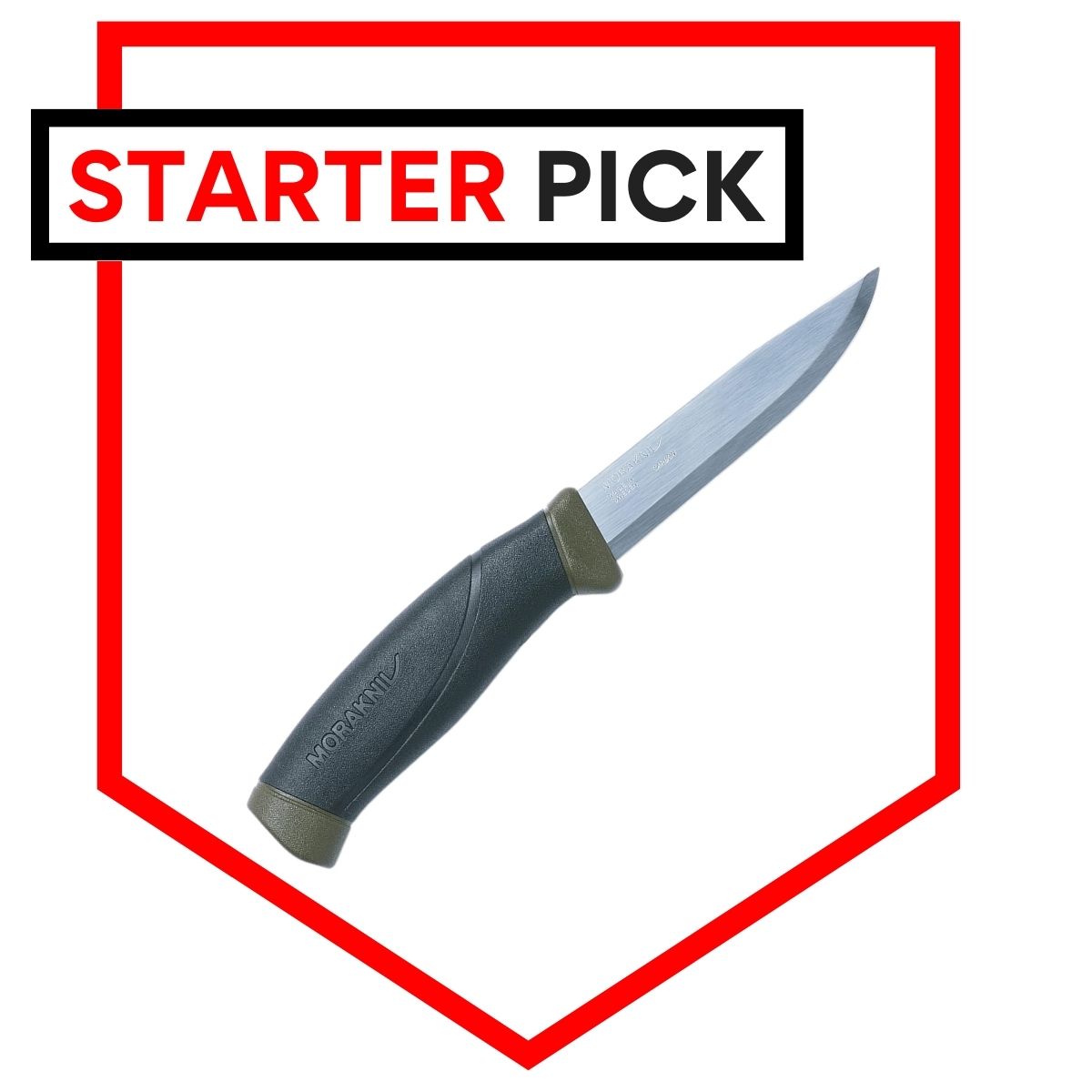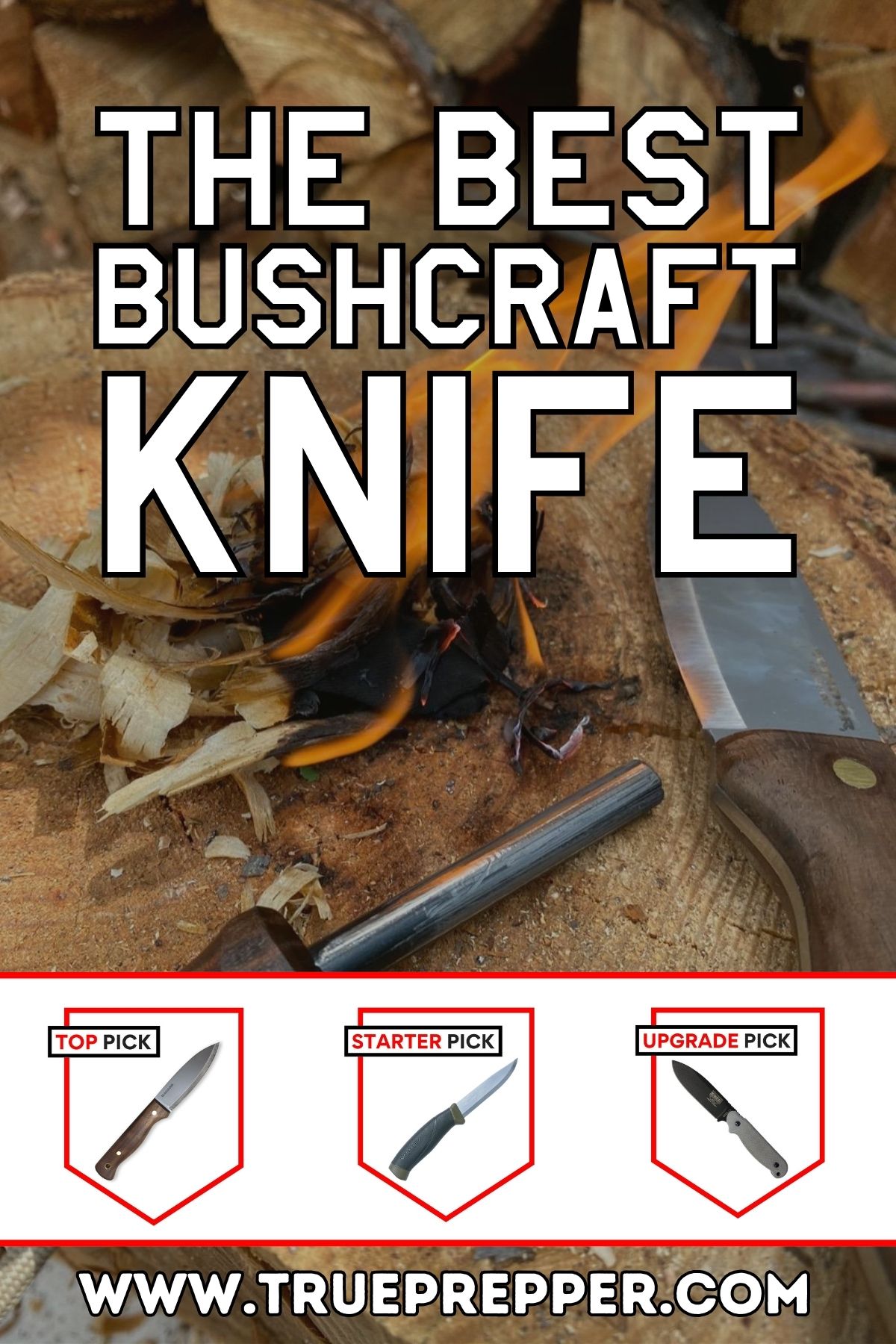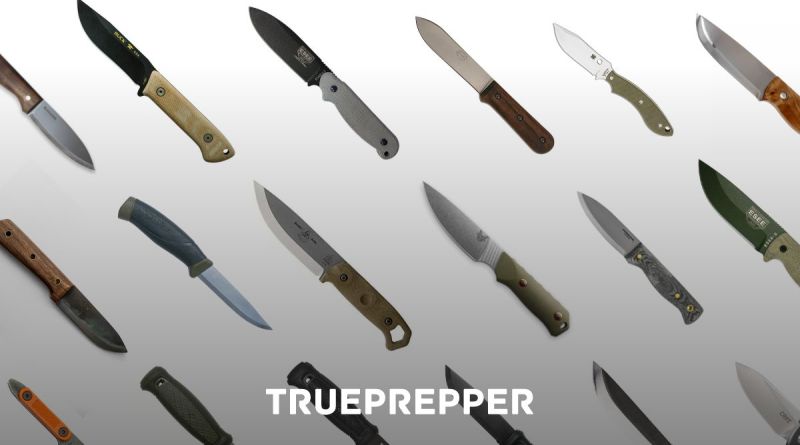Best Bushcraft Knife for Feathering, Batoning, and More
This is an updated review guide on the best bushcraft knife. Our first review roundup was over six years ago and we will continue to update as new products are released and as we gain experience with an even wider range of knives.
With all of the information out there, it can be tough to find the best bushcraft knife. People from many different walks of life embrace bushcraft, and many have different preferences for the best type of survival knife. Not to mention the sites pushing hollow handle ‘survival’ knives that wouldn’t survive one day’s hard use. Still, there are plenty of quality options out there to consider as your go-to bushcraft knife.
This is where we come in. We’ve researched the best bushcraft knives, tested each of them, and now the results are in: the overall best, a budget option, and an upgrade option. If you need a tough-as-dirt bushcraft knife, one of our picks will give you an edge.
Contents (Jump to a Section)
The Best Bushcraft Knife
Condor Bushlore
Proven, High Quality, and Durable
The performance, quality, and durability are unmatched when it comes to survival, tactical, and bushcraft knives.
*Price at time of publishing; check for price changes or sales.
We finally got our hands on a Bushlore and can see what the hype is about. It’s our new top pick giving us a great feel, a strong blade, and a versatile design.
- 1075 high-carbon steel
- Blade length: 4.25″
- Blade width: 0.125″ (3.1mm)
- Overall length: 9.25″
- 8.0 ounces
- Included leather sheath
- Made in El Salvador
If you want the best bushcraft knife that performs just as well as knives that cost hundreds of dollars more, pick up the Condor Bushlore.
Budget Bushcraft Knife
Morakniv Companion
Budget Friendly, Tough, and Lightweight
Universally known as the best bang-for-your-buck knife, Mora gets it right with their Companion model.
*Price at time of publishing; check for price changes or sales.
If you ask any experienced survivalist what the best budget bushcraft knife would be, they would almost always suggest a Morakniv. Morakniv is known for its quality blades, and the bushcraft knife is no exception. It does come in a few blade options, but we suggest carbon steel since it is easier to keep sharp. You may want to opt for the stainless blade option if you feel like you won’t be maintaining the blade with oil.
The Companion is one of the more affordable knives in the Morakniv catalog, making it a great starter knife for anyone. The spine is ground to 90 degrees, so using the fire starter is much easier. It is best to wipe the blade after each use and oil it regularly since it is carbon steel. It has a rubberized non-slip grip, making it great at filleting fish or other slimy requirements.
Here are the Companion details:
- High-carbon steel
- Blade length: 4.1″
- Blade width: 0.11″ (2mm)
- Overall length: 8.6″
- 2.3 ounces
- Included sheath
- Made in Sweden
If you are looking for a solid budget knife to start bushcrafting, pick up a Morakniv Companion.
Upgrade Bushcraft Knife
ESEE Laser Strike
Proven, High Quality, and Durable
The performance, quality, and durability are unmatched when it comes to bushcraft knives.
*Price at time of publishing; check for price changes or sales.
The ESEE knives come in a wide range of lengths and types, but we settled on the 4.75” Laser Strike. ESEE as a brand has a storied history grounded in survival and bushcraft, with the owners designing the well-known RTAK and RAT bushcraft knives for Ontario Knife Company, among others. The designers created their own company, which eventually became ESEE. They are now considered one of the best bushcraft knife makers in the business.
The Laser Strike is an ideal length for bushcraft and has a versatile spear point. It was originally made by TOPS knives, but now is made by ESEE and has the legendary warranty.
Here are the full specs:
- 1095 High carbon steel
- Blade length: 4.75″
- Blade width: 0.19″ (4.8mm)
- Overall length: 10.00″
- 9.4 ounces
- Micarta handle
- Included Kydex sheath
- Made in the USA
If you are looking for the best of the best and an heirloom quality knife, pick up the ESEE Laser Strike.
Everything We Recommend

The performance, quality, and durability are unmatched when it comes to survival, tactical, and bushcraft knives.
Where to Buy
*at time of reviewing

Universally known as the best bang-for-your-buck knife, Mora gets it right with their Companion model.
Where to Buy
*at time of reviewing
The Knives We Compared
Our research narrowed the field down to the several bushcraft knives that we tested: ESEE, Morakniv, Condor, Benchmade, Tops, Boker, Spyderco, Bark River, Fallkniven, OKC, and many more.
You can see our full list of review criteria below in the What to Look For section, with an explanation for each.
We’re always looking for new and better equipment, so if you have a knife that you swear by let us know in the comments. We review most of our tested gear annually, so we can always get it in the next roundup round and see if it makes the cut and we can see if it will beat out our top picks.
What to Look For
The best bushcraft knife has several important features to look for:
- Value
- Blade Material
- Blade Type
- Size & Weight
- Durability
When you get the right blend of these, you can find a reliable knife that will keep up with you in any bushcraft scenario. Below, we break down what each of these features means for knives that set themselves apart.
Value: Cost vs. Benefit
The amount of money you spend on something like a knife shouldn’t blow out your entire budget. Don’t go overspending or overdo it. Budget according to your risk and your needs rather than just spending lavishly.
On the flip side, you don’t want to go too cheap or just plain get the wrong thing. If the knife has a hollow handle with a compass glued to it, it’s not going to last more than a few days- much less a season- in a survival situation.
You never want to spend too much money on one resource, especially something like knives (I know, easier said than done!) It’s better to diversify your preparedness gear to make sure you are covered for a wide range of scenarios. There is a sweet spot where you get high value with not too high of a price, which is where our top pick sits.
Blade Material
There are many types of steel. With different alloys and carbon content, you can find all sorts of differences in:
- Toughness – resistance to breaking, chipping, and cracking
- Hardness – resistance to bending, warping, and denting
- Corrosion – rust, patina, and other stains
- Sharpening – how easily the blade can be sharpened
- Hold an edge – how quickly the knife edge dulls
Thicker, heavier-weight weaves will last longer. Quality can come into play, where the cloth should not have any picks or loose ends exposed to unravel.
Blade Type
A blade design that allows you to do all the usual bushcraft tasks would include a drop point, long cutting edge, and flat spine. This will allow you to baton, drill holes, carve, and feather wood easily. The flat spine will work great with a fire starter too. Other blade types that work well for bushcraft include the spear point, parang, and kukri, with the last two making great knife-machete hybrids.
The grind type is important on a bushcraft knife because it can affect how easy the knife is to maintain. A knife with a double bevel or axe grind can take some skill to sharpen on a flat stone.
Size & Weight
Most bushcraft knives you run into will have a blade of 4″ to 6″. The total length typically runs 7″ to 12″.
They usually have some heft to them because most bushcraft knives are full tang, or have the steel running through the entire handle. The Mora only has the 3/4 rattail design, so it is more lightweight than the other options.
All of these knives we suggest have great balance in the hand, so their size and weight depend on what you want for the most part. You should be able to feather, baton, etc. with any bushcraft knife that fits the bill.
Durability
We mentioned the blade material and type above, which affect durability- but so does the handle.
Most homemade bushcraft knives use wood as a handle since it is easy, workable, and relatively cheap. Store-bought bushcraft knives often opt for rubberized or composite handles since they work much better than wood in wet and muddy conditions.
One handle consideration is whether or not the blade is full tang. The Morakniv Bushcraft that we just suggested above, believe it or not, is not a full tang knife. While full tang knives have been a staple of good bushcraft knives, there have not been many reported problems with the Morakniv ‘rat tail’ style knife. I assume they left the extra steel out to save money, but it does not seem to impact the knife’s durability drastically.
Stay clear of hollow-handle survival knives. Although they seem like a great deal with all the storage in the handle, the sacrificed tang makes them very fragile and unreliable.
How to Make a Bushcraft Knife
One of the best ways to get connected to a knife and learn everything you need to know about it is to make one. Not everyone has the resources, time, or money- but if you do and are remotely interested, it can be a very rewarding experience. You can also personalize the shape, type, and materials of your knife. The YURT guide uses widely available materials to make a pretty good survival knife in just an afternoon.
If you are experienced in bushcraft, then knife making should be right up your alley with its shared emphasis on creating functional art. Many of the problem-solving skills you use for bushcraft will be needed to create your very own custom knife. The Knife Network Forum has an abundance of information on it and plenty of people willing to help you design your first knife. Check them out for more information on how to get into knife making.
If you are starting from scratch you can use primitive survival skills, like knapping, to make a bushcraft knife out of natural materials:
Who Needs a Bushcraft Knife?
A bushcraft knife isn’t necessary for any kit since you can survive or improvise without it. In certain situations (and if you anticipate certain threats) it can really come in handy.
They are also extremely lightweight (even the ‘heavyweight’ ones), so there are not many drawbacks to getting one into your kits.
We suggest that you consider adding one to your:
There are a ton of uses, so it is very unlikely that you will regret adding one to your kit if you can afford it.
How We Review Products: We research thoroughly before selecting the best products to review. We have vast prepping and survival experience and bring in outside experts when needed. Hours on end are spent testing gear in stressful conditions and using specialized testing gear to verify claims. We assign performance criteria and impartially rate each tested item. Learn more about how we test.
Sources and References
All of our experience and the testing we do to determine the best bushcraft knife is useless without listing our research sources and references. We leaned on these for the book knowledge that we paired with our hands-on testing and practical military and prepping experience:
Ayers, J. (2018). Survival Knives: How to Choose and Use the Right Blade. Simon and Shuster. New York, New York. (Source)
Fenton, L. (2016). ‘Bushcraft’ and ‘Indigenous Knowledge’: Transformations of a Concept in the Modern World. Dissertation: University of Kent. (Source)
Rhyder, J. (2021). Woodcraft: A Guide to Using Trees for Woodcraft and Bushcraft. The History Press. Cheltenham, Gloucestershire. (Source)
The Final Word
As mentioned earlier- personal preference and experience should weigh heavily on your choice. We would suggest the Morakniv for any beginner or anyone on a budget. Later on, you can pick up the ESEE and use both for a huge amount of functionality. Use the Morakniv to filet and do other delicate tasks, and the ESEE to baton and the ‘muscle’ tasks- you get the picture!
If you are biding your time to pick up your next knife check out Knife Deals, our favorite price tracker for all of our favorite survival knives.
Here are a few related articles our readers have also found helpful:
- The Best Survival Gloves | Reviews & Buying Guide
- The Survival Rule of 3 | Air, Shelter, Water, & Food
- INCH Bag Guide, Gear List, and Checklist
We presented quite a lot of information, but as always: if you have any questions let us know and we would be happy to help. Our research and testing found the Condor Bushlore Knife to be the best option given its value, blade material, blade type, size/weight, and durability.
If you pick up one of our suggested knives- make sure you know how to use it before you need it. They have unlimited uses, but it’s good to know the typical wraps so you aren’t bogged down when you need to throw one on.
Keep exploring, stay prepared, and be safe.
You’ve Been Missing Out
Join the 2+ million preppers that rely on our prepping advice by subscribing to TruePrepper.- Practical guides and tips
- Useful survival giveaways
- Free, forever
- < 0.4% of people unsubscribe




I prefer an American-made knife. My two main knives are a Buck 124 and an Ontario. Both are fixed-blade Bowie-style.
I just got the Ontario RAT folder for EDC and love it.
I like the Moras because they’re inexpensive and get the job done. I don’t typically go out into the woods with just a knife to survive so the Mora knives suit me pretty well.
I have a Condor Bushlore. I love the no-nonsense look and feel. Best leather sheath around, easy to sharpen, holds an edge very well. Best of all low price.
Agreed on the Bushlore
Are you serious? Is this article a joke? Yes, these are good knives, but are these the best bushcraft knives? No! The Mora Bushcraft is decent, but I find the handle uncomfortable. A Mora Kansbol is considered more versatile, and the Garberg is more durable. An ESEE Laser Strike is more versatile (with an extra .5″ of cutting edge) than an ESEE 4. How can you not mention Benchmade Bushcrafter or Spyderco Bushcraft?
Really, you need to choose. Either a bushcraft knife or a survival knife or both. Trying to make one knife fill both roles will result in a compromise that performs neither role well.
A Mora Companion/Kansbol (or even an Eldris) with a Ka-Bar BK7/BK9/BK21 is a great bushcraft/survival knife combination.